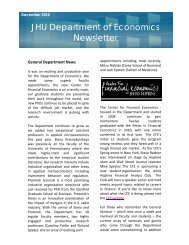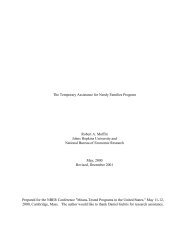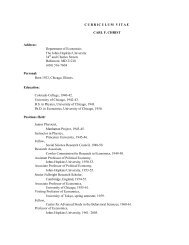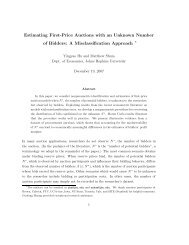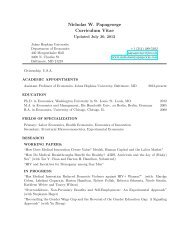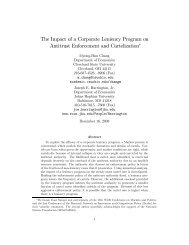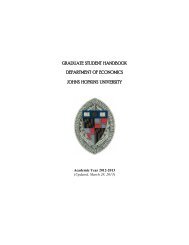WinEdt and TeX: step-by-step guide...
WinEdt and TeX: step-by-step guide...
WinEdt and TeX: step-by-step guide...
You also want an ePaper? Increase the reach of your titles
YUMPU automatically turns print PDFs into web optimized ePapers that Google loves.
<strong>WinEdt</strong> <strong>and</strong> <strong>TeX</strong><br />
<strong>WinEdt</strong> <strong>and</strong> <strong>TeX</strong>: <strong>step</strong>-<strong>by</strong>-<strong>step</strong> <strong>guide</strong>...<br />
<strong>WinEdt</strong> is <strong>by</strong> default already configured for MiK<strong>TeX</strong>. No changes to PATH are required in order to make <strong>WinEdt</strong> work with properly installed<br />
MiK<strong>TeX</strong>. All you have to do after installing or updating a <strong>TeX</strong> System is to restart <strong>WinEdt</strong> in order to give it a chance to detect your <strong>TeX</strong> System<br />
or Ghostscript. Reinstalling <strong>WinEdt</strong> is not required <strong>and</strong> will not improve the integration with other accessories. Below is an illustrated tutorial<br />
explaining the idea of writing La<strong>TeX</strong> documents with <strong>WinEdt</strong> <strong>and</strong> MiK<strong>TeX</strong>. The instructions are written with a first-time user in mind, although<br />
more experienced users, too, might benefit from reading <strong>and</strong> learning about <strong>WinEdt</strong>'s capabilities, which have been designed to assist you maintain<br />
<strong>and</strong> navigate your source code...<br />
In this section we show <strong>WinEdt</strong> in action <strong>by</strong> illustrating the Edit-Compile-Preview cycle. Note that <strong>WinEdt</strong>'s documentation does not deal with the<br />
syntax of La<strong>TeX</strong>. The fastest way to learn [La]<strong>TeX</strong> is to base your work on the examples of similar nature. Extensive documentation <strong>and</strong> literature<br />
about the art of typesetting in <strong>TeX</strong> is also widely available. You'll find downloads, links <strong>and</strong> references on <strong>TeX</strong> Users Group (TUG) home page:<br />
http://www.tug.org<br />
Here we focus on <strong>WinEdt</strong>'s role in <strong>TeX</strong>-ing! Not all <strong>TeX</strong> Systems include <strong>TeX</strong>ify accessories <strong>and</strong> not all previewers support src specials <strong>and</strong> DVI<br />
Search. Our example works with MiK<strong>TeX</strong> 2.4 (default <strong>WinEdt</strong>'s Configuration) which supports many extras (beyond basic <strong>TeX</strong>-ing)...<br />
<strong>WinEdt</strong>'s Options -> Configurations Menu allows you to instantly switch between MiK<strong>TeX</strong> <strong>and</strong> <strong>TeX</strong> Live configurations should you decide to<br />
give both <strong>TeX</strong> Systems a try:<br />
If you want to use <strong>WinEdt</strong> with <strong>TeX</strong> Live, you should execute the menu comm<strong>and</strong>:<br />
Options -> Configurations -> <strong>TeX</strong> Live<br />
This will reconfigure <strong>WinEdt</strong> for <strong>TeX</strong> Live distribution. After that <strong>WinEdt</strong> will automatically detect properly installed <strong>TeX</strong> Live System <strong>and</strong> the rest<br />
of the instructions in this section apply.<br />
An "empty" copy of <strong>WinEdt</strong> is running:<br />
http://www.winedt.com/tex.html<br />
Page 1 of 13<br />
3/9/2008
<strong>WinEdt</strong> <strong>and</strong> <strong>TeX</strong><br />
Page 2 of 13<br />
Most of the Menu Items <strong>and</strong> associated tool bar buttons are disabled. In particular, all <strong>TeX</strong> Icons are currently disabled. This does not mean that<br />
<strong>WinEdt</strong> cannot find your <strong>TeX</strong>. It simply indicates that currently there is no <strong>TeX</strong> document loaded. As soon as you'll open or create a <strong>TeX</strong><br />
document the compilation comm<strong>and</strong>s will become enabled. For our purpose let's open a Sample Thesis that comes with <strong>WinEdt</strong>:<br />
http://www.winedt.com/tex.html<br />
3/9/2008
<strong>WinEdt</strong> <strong>and</strong> <strong>TeX</strong><br />
Page 3 of 13<br />
After the file is opened, build the tree <strong>and</strong> navigation bar <strong>by</strong> pressing the first icon in the tree's control toolbar (docked in on left). That's more like<br />
it:<br />
http://www.winedt.com/tex.html<br />
3/9/2008
<strong>WinEdt</strong> <strong>and</strong> <strong>TeX</strong><br />
Compilation comm<strong>and</strong>s such as [PDF] <strong>TeX</strong>ify, La<strong>TeX</strong> <strong>and</strong> <strong>TeX</strong> are now enabled indicating that we can compile the current <strong>TeX</strong> Project with the<br />
compiler of our choice (since this is a La<strong>TeX</strong> document we have to use La<strong>TeX</strong> version of the <strong>TeX</strong> compiler). MiK<strong>TeX</strong>'s <strong>TeX</strong>ify accessory can be<br />
used to perform a full compile (run the compiler, Bib<strong>TeX</strong> <strong>and</strong> MakeIndex as many times as necessary to update the references, bibliography <strong>and</strong><br />
index). This would be the fastest way to compile the document but for educational purposes we'll take care of things manually. Note that certain<br />
comm<strong>and</strong>s are still disabled. There is good reason for that: DVI Preview or dvi2ps require the dvi file (which will be created <strong>by</strong> the <strong>TeX</strong> Compiler)<br />
<strong>and</strong> currently this file doesn't exists. Let's make it! Ready? Press the La<strong>TeX</strong> button...<br />
By default (depending on your choice of the Execution Mode) the Console Window (with black background) appears <strong>and</strong> La<strong>TeX</strong> is doing its thing:<br />
complaining about some undefined references <strong>and</strong> citations <strong>and</strong> displaying the page numbers as it progresses through the text. When there are no<br />
Errors the Windows disappears quite fast <strong>and</strong> you are not expected to process the feedback from the console Window. In <strong>WinEdt</strong> you can Press the<br />
Ctrl+E (Errors... Comm<strong>and</strong> in the Search Menu) shortcut to display the LOG file at the bottom of the screen. This file contains all the information<br />
produced <strong>by</strong> <strong>TeX</strong>. Furthermore, subsequent comm<strong>and</strong> search the LOG file for errors <strong>and</strong> warnings <strong>and</strong> display the corresponding line in <strong>WinEdt</strong>.<br />
Although the warnings in the current LOG file are not serious (they will disappear once we compile the bibliography <strong>and</strong> re-compile the source)<br />
let's try it (you can either keep on pressing Ctrl+E to "walk" through the errors or else use the GUI in the Error Form). To close the Errors dialog<br />
click on the X in the left top corner of the form or use the Shift+Ctrl+E shortcuts....<br />
By the way, the location of the Error Form can be changed in the Appearance Dialog. By default the from is docked at the bottom of the Client<br />
Window but this can be changed if you don't like it there.<br />
<strong>WinEdt</strong> <strong>and</strong> YAP<br />
Page 4 of 13<br />
You have noticed that DVI Search <strong>and</strong> Preview <strong>and</strong> dvi2ps comm<strong>and</strong>s are now enabled: the file Thesis.dvi exists <strong>and</strong> the comm<strong>and</strong>s now make<br />
sense. Let us first get rid of all the Warnings <strong>by</strong> properly compiling the bibliography. Press the Button Bib<strong>TeX</strong> <strong>and</strong> then La<strong>TeX</strong> two more times to<br />
get all the cross-references right (<strong>TeX</strong>ify does all that in one <strong>step</strong>)... There are no more Warnings or Errors. Close the LOG file (X in the top left<br />
corner of the Error Form). Now press the DVI Preview Button. The previewer starts (in MiK<strong>TeX</strong> it is called YAP). Move a few pages down <strong>and</strong><br />
see how the compiled document looks.<br />
http://www.winedt.com/tex.html<br />
3/9/2008
<strong>WinEdt</strong> <strong>and</strong> <strong>TeX</strong><br />
Note that your actual position was in the Introduction Chapter (T0.tex). So, how did <strong>WinEdt</strong> know to compile the main file Thesis.tex rather<br />
than the current chapter (which would fail to compile without a proper preamble present in the main file). This is because Thesis.tex is set as the<br />
main file. To remove or set the current file as the main document use the comm<strong>and</strong>s in the Project Menu or the "+/-" buttons in the toolbar. For<br />
your Convenience the name of the currently set main file is displayed in the last panel of <strong>WinEdt</strong>'s Status Line. When you'll start working on your<br />
projects you should (re)set the main file to your main document or else remove it if you are working on a simple one source file <strong>TeX</strong> document.<br />
SRC Specials <strong>and</strong> DVI Search<br />
Page 5 of 13<br />
<strong>WinEdt</strong>'s Status Line displays a panel "--src" (it can be toggled between empty <strong>and</strong> "--src" <strong>by</strong> clicking on it. The "--src" comm<strong>and</strong> qualifier<br />
instructs <strong>TeX</strong> to insert "SRC Specials" in the resulting dvi file. These specials allow the previewer to link the compiled document with the actual<br />
position in the source file (within a few lines). This makes the Forward <strong>and</strong> Inverse DVI Search possible. Go back to <strong>WinEdt</strong>: you are currently at<br />
the position of previously undefined citation. Press the Button DVI Search. YAP now starts displaying the position roughly corresponding to your<br />
current position in <strong>WinEdt</strong>. Note a circle in YAP marking the current line:<br />
http://www.winedt.com/tex.html<br />
3/9/2008
<strong>WinEdt</strong> <strong>and</strong> <strong>TeX</strong><br />
Inverse Search<br />
Page 6 of 13<br />
Even more useful is the Inverse DVI Search which can be initiated from the previewer (<strong>by</strong> double-clicking on a preview) <strong>and</strong> as a result the editor<br />
displays the corresponding source line (again there is margin of error since the exact position may not be available from the inserted src specials).<br />
For example, in YAP go to Page 50 (see the View -> Go To Menu in YAP) <strong>and</strong> double-click on the displayed equation (at the <strong>and</strong> of the<br />
Definition 3.3.3):<br />
http://www.winedt.com/tex.html<br />
3/9/2008
<strong>WinEdt</strong> <strong>and</strong> <strong>TeX</strong><br />
<strong>WinEdt</strong> gets in the foreground, Opens Chapter 3 <strong>and</strong> highlights the corresponding line:<br />
http://www.winedt.com/tex.html<br />
Page 7 of 13<br />
3/9/2008
<strong>WinEdt</strong> <strong>and</strong> <strong>TeX</strong><br />
DVI Search is an extremely useful feature since it allows you to quickly correct errors spotted while you are examining the compiled document.<br />
However, for this to work as indicated above you have to define the comm<strong>and</strong> that should be used <strong>by</strong> YAP to initiate the Inverse Search. By<br />
default, YAP may be configured so as to call some other editor (eg. Windows Notepad).<br />
In YAP's View Menu start the Options Dialog <strong>and</strong> click on the Inverse Search Tab:<br />
http://www.winedt.com/tex.html<br />
Page 8 of 13<br />
3/9/2008
<strong>WinEdt</strong> <strong>and</strong> <strong>TeX</strong><br />
Enter<br />
<strong>WinEdt</strong>.exe "[Open(|%f|);SelPar(%l,8)]"<br />
as a comm<strong>and</strong> line <strong>and</strong> leave the drop-down (Program) list empty. Your version of YAP may be configured differently. You should consult YAP's<br />
documentation for detailed instructions (<strong>WinEdt</strong> is irrelevant to this YAP's configuration issue). Based on the information provided <strong>by</strong> YAP (or<br />
some other previewer) you should find the way to specify the editor <strong>and</strong> enter the comm<strong>and</strong> line as indicated above. Not all dvi viewers support<br />
SRC specials!<br />
You have seen enough to be able to do the same procedure with PDF La<strong>TeX</strong> <strong>and</strong> create a pdf file which can be previewed in Acrobat Reader. Note<br />
that there is no "--src" support for this format. Alternatively, dvi2pdf converter yields a very similar result.<br />
You can also create a ps file using dvi2ps converter. The resulting "ps" (postscript) file can be previewed <strong>and</strong> printed with GSView (you'll find a<br />
link on <strong>TeX</strong> Users Group home page).<br />
Taking advantage of <strong>WinEdt</strong>'s capabilities...<br />
By now you are probably eager to start working on your own projects. However, let us use this opportunity to illustrate some advanced <strong>WinEdt</strong><br />
features which will make your work easier...<br />
When you setup your project it is important that you set the main file <strong>and</strong> build the project tree. The items in the Project Menu (or the associated<br />
tool bar buttons) can be used to accomplish the task. Even if you don't want tree visible (in your left panel, you should let <strong>WinEdt</strong> build it for the<br />
purpose of automatic referencing).<br />
<strong>WinEdt</strong> builds the project tree based on the Input Directives as specified in the Options -> Advanced -> Tree (Tree.ini file). Directives are<br />
mode-sensitive (since different rules apply to different document formats). By default you'll find something like:<br />
[INPUT_DIRECTIVES]<br />
// BEGINNING_OF_LINE_ONLY<br />
// 0 - any position is admissible<br />
// 1 - Beginning of line or indented<br />
// 2 - Beginning of line only<br />
INPUT="<strong>TeX</strong>"<br />
MODE="<strong>TeX</strong>"<br />
MAX_TREE_DEPTH=9<br />
OPEN_ON_DBL_CLICK=1<br />
BEGINNING_OF_LINE_ONLY=1<br />
CASE_SENSITIVE=1<br />
FILE_MUST_EXIST=1<br />
ALLOW_RECURSIVE_INCLUSION=0<br />
ALLOW_MUTIPLE_SIBLINGS_INCLUSION=0<br />
ALLOW_MULTIPLE_INCLUSION=1<br />
INCLUDE_TYPE_FILTER="tex;ltx;texi;dtx;ins;bib;bbl;txt"<br />
RECURSE_TYPE_FILTER="tex;ltx;texi;dtx;ins;bib;bbl;txt"<br />
DIRECTIVE="\include{""?""}"<br />
DIRECTIVE="\input{""?""}"<br />
DIRECTIVE="\input ""?"""<br />
DIRECTIVE="\include{?}"<br />
DIRECTIVE="\input{?}"<br />
DIRECTIVE="\input ?"<br />
// Extended Input for bibliography (exp<strong>and</strong>s any <strong>TeX</strong> \PATH specifications!)<br />
// Use PATH sparingly as it may take a long time to build the tree otherwise...<br />
// {??}: allows a list in up to two lines - extended it if required {????}<br />
DIRECTIVE="\bibliography{??}"<br />
FILENAME="%[!|Exe('%b\Macros\GetBibFiles.edt');|];%$('_ExTreeInput');"<br />
SEPARATOR="," // allows comma separated list of bib files<br />
EXTENSION=".;.bib" // possible extensions (.=default [.bib] as appended <strong>by</strong> the above macro)<br />
PATH="%P;%p" // add additional locations for your bib files, eg.:<br />
// "%P;%p;%$('<strong>TeX</strong>-Local');\bibtex;C:\<strong>TeX</strong>\bibtex\My Bib Files"<br />
// Extended Input for import.sty (example)<br />
DIRECTIVE="\includefrom{?}{?}"<br />
FILENAME="%[!|Exe('%b\Macros\IncludeFrom.edt');|];%$('_ExTreeInput');"<br />
// Gather Input Directives (Comments)<br />
DIRECTIVE="%input ""?"""<br />
// Obsolete: For (
<strong>WinEdt</strong> <strong>and</strong> <strong>TeX</strong><br />
If you type \cite{} you activate an "Active String" which displays a list of sorted citations in a special interface. Double-clicking any of the items<br />
displays the bib record while pressing Enter inserts the citation between curly brackets: try it!<br />
Enter inserts the selected citation, while ESC closes the interface without taking any further action.<br />
GDI Popup interface also responds to the following shortcuts:<br />
F2 - Toggle the Visibility of Extra Buttons<br />
F3 - Track Source File<br />
F4 - Return to the Insertion Point<br />
F5 - Refresh Data<br />
F6 - Toggle Sorted Property (Sort/Unsort)<br />
Enter - Return <strong>and</strong> Insert the Selected Item<br />
ESC - Return <strong>and</strong> exit without inserting the Selected Item<br />
IMPORTANT:<br />
The most common reason for the active string \cite{} to "stop working" is that <strong>WinEdt</strong> does not know where to collect bib items. For<br />
example the Main File might not have been set of else bibliography file is located in a folder that <strong>WinEdt</strong> is not aware of.<br />
<strong>WinEdt</strong> builds the tree based on Input Directives (as specified in the Options -> Advanced -> Tree interface: Tree.ini file). Directives<br />
are mode-sensitive (since different rules apply to different document formats).<br />
Bibliography files can be placed in the same folder as the Main File. However, since such data is usually shared between your projects you<br />
might do better to create a global bibliography <strong>and</strong> place it in your Bib<strong>TeX</strong> folder in the local texmf tree. <strong>TeX</strong>'s Manual explains how to do<br />
this <strong>and</strong> describes any other actions that should be taken. Eg., MiK<strong>TeX</strong>'s Users have to use MiK<strong>TeX</strong>'s Options Interface to refresh its FNDB<br />
(the filename database). Note that <strong>WinEdt</strong> is not aware of the folders where your <strong>TeX</strong> accessories look for input or bib files. If you decide to<br />
use the global Bibliography Data base you should specify this folder as a part of a search path for Input Directive \bibliography{?}. This<br />
is done <strong>by</strong> modifying the Input Directive Section in Tree.ini (Options -> Advanced: Tree). For example:<br />
DIRECTIVE="\bibliography{??}"<br />
FILENAME="%[!|Exe('%b\Macros\GetBibFiles.edt');|];%$('_ExTreeInput');"<br />
// allows comma separated list of bib files<br />
SEPARATOR=","<br />
// possible extensions (.=default [.bib] as appended <strong>by</strong> the above macro)<br />
EXTENSION=".;.bib"<br />
// add additional locations for your bib files, eg.:<br />
// "%P;%p;%$('<strong>TeX</strong>-Local');\bibtex;C:\<strong>TeX</strong>\bibtex\My Bib Files"<br />
PATH="%P;%p;C:\localtexmf\bibtex\myBib.bib"<br />
The new extended Input Directives in <strong>WinEdt</strong> 5.5 make the old "dummy" input directives redundant (as long as Tree.ini is properly<br />
configured). However, it is still possible to use a dummy input directive:<br />
%Included for Gather Purpose only:<br />
%input "C:\localtexmf\bibtex\myBib.bib"<br />
Since <strong>TeX</strong> treats this line as a comment, this does not reduce portability of your documents. Once again: if <strong>TeX</strong> or Bib<strong>TeX</strong> cannot find any<br />
of your input files this is not a <strong>WinEdt</strong>-related problem. Consult the Manual that comes with your <strong>TeX</strong> System!<br />
If you prefer to work on simple one-document projects without setting the main file or building the tree you may want to change the default<br />
settings in Gather.ini so as to collect bibliography items in all opened documents. <strong>WinEdt</strong>'s Macro Manual describes how to further<br />
customize the Gather Interface.<br />
If you organize your <strong>TeX</strong> project in subfolders relative to the main file you have to use UNIX-style folder specification in "proper" include<br />
directives. For example:<br />
<strong>and</strong> not<br />
\include{chapter1/section1.tex}<br />
http://www.winedt.com/tex.html<br />
Page 10 of 13<br />
3/9/2008
<strong>WinEdt</strong> <strong>and</strong> <strong>TeX</strong><br />
\include{chapter1\section1.tex}<br />
<strong>WinEdt</strong> underst<strong>and</strong>s both but <strong>TeX</strong> does not "like" backslashes "\" in filenames: you must use UNIX-style forward slashes instead!<br />
Responses such as "\cite{}" are defined in <strong>WinEdt</strong> as Active Strings: typing any such string triggers the execution of the associated macro. Such<br />
responses are defined in the Settings Dialog <strong>and</strong> the Help in that dialog explains the concept of active strings in details.<br />
There are plenty of such strings defined but not necessary enabled in the default settings. Depending on your style of editing you may want to<br />
enable more such responses (eg. automatic insertion of closing brackets). For example if you type:<br />
\begin{proof}}<br />
in a <strong>TeX</strong> document the active string "\begin{?}}" kicks in <strong>and</strong> automatically completes your environment <strong>by</strong> inserting a properly indented "\end<br />
{proof}" <strong>and</strong> placing the cursor in the middle... Similarly, "\begin{?}>" allows you to change the name of the current environment (you are<br />
prompted for a new name <strong>and</strong> both \begin <strong>and</strong> \end are properly updated...). You don't have to be an expert in <strong>WinEdt</strong>'s Macro language to enable<br />
or disable such responses or even add your custom ones based on the existing examples.<br />
Beside the tree form <strong>and</strong> navigation bar <strong>WinEdt</strong> can also collect certain items in your project files <strong>and</strong> display them in a special "Gather" form at<br />
the bottom of your screen. Such data can be used for navigating <strong>and</strong> cross referencing.<br />
Gather Interface is organized according to the Gather directives, which are specified in the (advanced) configuration file Gather.ini (Options -><br />
Advanced: Gather). Gather Directives are mode-dependent to allow for different rules to be applied for different types of documents.<br />
<strong>WinEdt</strong>'s Macro Manual describes the particulars of customizing the Gather Interface....<br />
Page 11 of 13<br />
If you press the "Sigma" button in the default Toolbar <strong>WinEdt</strong> displays a special GUI consisting of over 500 La<strong>TeX</strong> symbols (organized in a few<br />
pages). Pressing the button again hides the control:<br />
http://www.winedt.com/tex.html<br />
3/9/2008
<strong>WinEdt</strong> <strong>and</strong> <strong>TeX</strong><br />
Important: if you want to use all the symbols in your La<strong>TeX</strong> Document you should load the amsmath package in your preamble:<br />
\usepackage{amsmath}<br />
\usepackage{amsxtra}<br />
\usepackage{amstext}<br />
\usepackage{amssymb}<br />
\usepackage{latexsym}<br />
\usepackage{dsfont} % for \mathds{N}<br />
Page 12 of 13<br />
The file "_Gui Source.tex" in <strong>WinEdt</strong>'s Bitmaps\GUI folder describes how the images were generated (it is time-consuming but it can be<br />
customized)... The file can be opened through Documents -> Current Work (Samples) -> GUI Symbols menu comm<strong>and</strong>.<br />
http://www.winedt.com/tex.html<br />
3/9/2008
<strong>WinEdt</strong> <strong>and</strong> <strong>TeX</strong><br />
Page 13 of 13<br />
Graphics inclusion in La<strong>TeX</strong> documents is not a <strong>WinEdt</strong>-related issue. You are wasting your (<strong>and</strong> our) time if you are writing with such questions.<br />
However, the sample La<strong>TeX</strong> Demo in the above menu illustrates <strong>and</strong> describes how it can be done. Assuming that you have a properly installed<br />
MiK<strong>TeX</strong> <strong>and</strong> Ghostscript, the sample compiles into dvi, ps, or pdf <strong>by</strong> any available procedure in the default settings (try it!). La<strong>TeX</strong> Demo also<br />
contains useful hints when it comes to <strong>TeX</strong> <strong>and</strong> international characters <strong>and</strong> other [La]<strong>TeX</strong> related issues. If you need more help you'll have to<br />
consult the resources <strong>and</strong> documentation on www.tug.org where you'll also find recommended literature that will make your <strong>TeX</strong>-ing enjoyable<br />
<strong>and</strong> stress-free...<br />
http://www.winedt.com/tex.html<br />
3/9/2008



